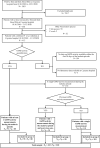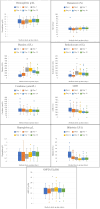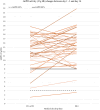Kinetics of glucose-6-phosphate dehydrogenase (G6PD) activity during Plasmodium vivax infection: implications for early radical malaria treatment
- PMID: 38725027
- PMCID: PMC11080303
- DOI: 10.1186/s12936-024-04973-4
Kinetics of glucose-6-phosphate dehydrogenase (G6PD) activity during Plasmodium vivax infection: implications for early radical malaria treatment
Abstract
Background: Plasmodium vivax relapses due to dormant liver hypnozoites can be prevented with primaquine. However, the dose must be adjusted in individuals with glucose-6-phosphate-dehydrogenase (G6PD) deficiency. In French Guiana, assessment of G6PD activity is typically delayed until day (D)14 to avoid the risk if misclassification. This study assessed the kinetics of G6PD activity throughout P. vivax infection to inform the timing of treatment.
Methods: For this retrospective monocentric study, data on G6PD activity between D1 and D28 after treatment initiation with chloroquine or artemisinin-based combination therapy were collected for patients followed at Cayenne Hospital, French Guiana, between January 2018 and December 2020. Patients were divided into three groups based on the number of available G6PD activity assessments: (i) at least two measurements during the P. vivax malaria infection; (ii) two measurements: one during the current infection and one previously; (iii) only one measurement during the malaria infection.
Results: In total, 210 patients were included (80, 20 and 110 in groups 1, 2 and 3, respectively). Data from group 1 showed that G6PD activity remained stable in each patient over time (D1, D3, D7, D14, D21, D28). None of the patients with normal G6PD activity during the initial phase (D1-D3) of the malaria episode (n = 44) was categorized as G6PD-deficient at D14. Patients with G6PD activity < 80% at D1 or D3 showed normal activity at D14. Sex and reticulocyte count were statistically associated with G6PD activity variation. In the whole sample (n = 210), no patient had severe G6PD deficiency (< 10%) and only three between 10 and 30%, giving a G6PD deficiency prevalence of 1.4%. Among the 100 patients from group 1 and 2, 30 patients (26.5%) were lost to follow-up before primaquine initiation.
Conclusions: In patients treated for P. vivax infection, G6PD activity did not vary over time. Therefore, G6PD activity on D1 instead of D14 could be used for primaquine dose-adjustment. This could allow earlier radical treatment with primaquine, that could have a public health impact by decreasing early recurrences and patients lost to follow-up before primaquine initiation. This hypothesis needs to be confirmed in larger prospective studies.
Keywords: Plasmodium vivax; French Guiana; G6PD/Glucose-6-phosphase dehydrogenase; Malaria; Primaquine.
© 2024. The Author(s).
Conflict of interest statement
The authors report no competing interest in this work.
Figures






Similar articles
-
Primaquine alternative dosing schedules for preventing malaria relapse in people with Plasmodium vivax.Cochrane Database Syst Rev. 2020 Aug 19;8:CD012656. doi: 10.1002/14651858.CD012656.pub3. Cochrane Database Syst Rev. 2020. PMID: 32816320
-
UK malaria treatment guidelines 2016.J Infect. 2016 Jun;72(6):635-649. doi: 10.1016/j.jinf.2016.02.001. Epub 2016 Feb 12. J Infect. 2016. PMID: 26880088 Free PMC article.
-
High daily dose Short COurse PrimaquinE after G6PD testing for the radical cure of Plasmodium vivax malaria in Indonesia and Papua New Guinea: the SCOPE implementation study protocol.BMC Infect Dis. 2025 Jul 16;25(1):922. doi: 10.1186/s12879-025-11109-9. BMC Infect Dis. 2025. PMID: 40670924 Free PMC article.
-
Primaquine at alternative dosing schedules for preventing relapse in people with Plasmodium vivax malaria.Cochrane Database Syst Rev. 2019 Jul 5;7(7):CD012656. doi: 10.1002/14651858.CD012656.pub2. Cochrane Database Syst Rev. 2019. Update in: Cochrane Database Syst Rev. 2020 Aug 19;8:CD012656. doi: 10.1002/14651858.CD012656.pub3. PMID: 31274189 Free PMC article. Updated.
-
Operational effectiveness of tafenoquine and primaquine for the prevention of Plasmodium vivax recurrence in Brazil: a retrospective observational study.Lancet Infect Dis. 2024 Jun;24(6):629-638. doi: 10.1016/S1473-3099(24)00074-4. Epub 2024 Mar 4. Lancet Infect Dis. 2024. PMID: 38452779 Free PMC article.
Cited by
-
[Malaria control in French Guiana: What are the challenges in this last endemic French territory in 2024?].Med Trop Sante Int. 2025 Mar 20;5(1):mtsi.v5i1.2025.536. doi: 10.48327/mtsi.v5i1.2025.536. eCollection 2025 Mar 31. Med Trop Sante Int. 2025. PMID: 40248577 Free PMC article. French.
References
-
- WHO . World malaria report 2022. Geneva: World Health Organization; 2022.
-
- WHO . Guidelines for malaria. Geneva: World Health Organization; 2023.
MeSH terms
Substances
LinkOut - more resources
Full Text Sources
Miscellaneous

